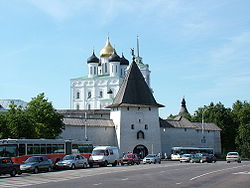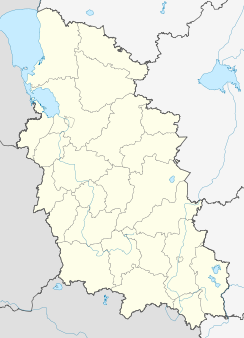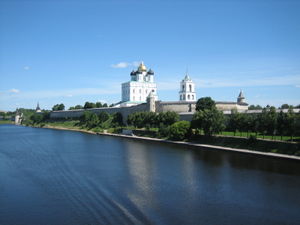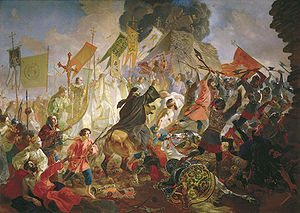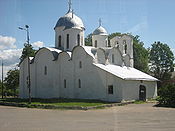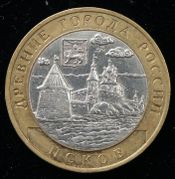- Pskov
-
Pskov (English)
Псков (Russian)- City[citation needed] -
Krom (or Kremlin) in Pskov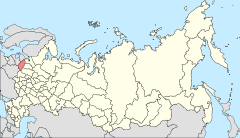
Location of Pskov Oblast in RussiaCoordinates: 57°49′N 28°20′E / 57.817°N 28.333°ECoordinates: 57°49′N 28°20′E / 57.817°N 28.333°E Coat of arms Flag City Day July 23[citation needed] Administrative status Country Russia Federal subject Pskov Oblast Administrative center of Pskov Oblast, Pskovsky District[citation needed] Municipal status Urban okrug Pskov Urban Okrug[citation needed] City Head[citation needed] Ivan Tsetsersky[citation needed] Representative body City Duma[citation needed] Statistics Area 95.5 km2 (36.9 sq mi)[citation needed] Population (2010 Census,
preliminary)203,281 inhabitants[1] - Rank in 2010 91st Population (2002 Census) 202,780 inhabitants[2] - Rank in 2002 90th Density 2,129 /km2 (5,510 /sq mi)[3] Time zone MSD (UTC+04:00)[4] Founded 903[citation needed] Postal code(s) 180xxx[citation needed] Dialing code(s) +7 8112[citation needed] Official website Pskov (Russian:
 Псков (help·info), ancient Russian spelling "Плѣсковъ", Pleskov) is an ancient city and the administrative center of Pskov Oblast, Russia, located in the northwest of Russia about 20 kilometers (12 mi) east from the Estonian border, on the Velikaya River. Population: 203,281 (2010 Census preliminary results);[1] 202,780 (2002 Census);[2] 203,789 (1989 Census).[5]
Псков (help·info), ancient Russian spelling "Плѣсковъ", Pleskov) is an ancient city and the administrative center of Pskov Oblast, Russia, located in the northwest of Russia about 20 kilometers (12 mi) east from the Estonian border, on the Velikaya River. Population: 203,281 (2010 Census preliminary results);[1] 202,780 (2002 Census);[2] 203,789 (1989 Census).[5]Contents
Early history
The name of the city, originally spelled "Pleskov", may be loosely translated as "[the town] of purling waters". Its earliest mention comes in 903, which records that Igor of Kiev married a local lady, St. Olga. Pskovians sometimes take this year as the city's foundation date, and in 2003 a great jubilee took place to celebrate Pskov's 1,100th anniversary.
The first prince of Pskov was St. Vladimir's younger son Sudislav. Once imprisoned by his brother Yaroslav, he was not released until the latter's death several decades later. In the 12th and 13th centuries, the town adhered politically to the Novgorod Republic. In 1241, it was taken by the Teutonic knights, but Alexander Nevsky recaptured it several months later during a legendary campaign dramatized in Sergei Eisenstein's 1938 movie.
In order to secure their independence from the knights, the Pskovians elected a Lithuanian prince, named Daumantas, a Roman Catholic converted to Orthodox faith and known in Russia as Dovmont, as their military leader and prince in 1266. Having fortified the town, Daumantas routed the Teutonic knights at Rakvere and overran much of Estonia. His remains and sword are preserved in the local kremlin, and the core of the citadel, erected by him, still bears the name of "Dovmont's town".
Pskov Republic
By the 14th century, the town functioned as the capital of a de-facto sovereign republic. Its most powerful force was the merchants who brought the town into the Hanseatic League. Pskov's independence was formally recognized by Novgorod in 1348. Several years later, the veche promulgated a law code (called the Pskov Charter) which was one of the principal sources of the all-Russian law code issued in 1497.
For Russia, the Pskov Republic was a bridge towards Europe. For Europe, it was a western outpost of Russia and a subject of numerous attacks throughout its history. The Pskov Krom (or Kremlin) withstood 26 sieges in the 15th century alone. At one point, five stone walls ringed it, making the city practically impregnable. A local school of icon-painting flourished, and local masons were considered the best in Russia. Many peculiar features of Russian architecture were first introduced in Pskov.
Finally, in 1510, the city fell to Muscovite forces.[6] The deportation of noble families to Moscow is a subject of Rimsky-Korsakov's opera Pskovityanka (1872). As the second largest city of Muscovy, Pskov still attracted enemy armies. Most famously, it withstood a prolonged siege by a 50,000-strong Polish army during the final stage of the Livonian War (1581–1582). The king of Poland Stefan Batory undertook some 31 attacks to storm the city, which was defended mainly by civilians. Even after one of the city walls was broken, the Pskovians managed to fill the gap and repel the attack. "It's amazing how the city reminds me of Paris", wrote one of the Frenchmen present at Batory's siege.
Modern history
Peter the Great's conquest of Estonia and Latvia during the Great Northern War in the early 18th century spelled the end of Pskov's traditional role as a vital border fortress and a key to Russia's interior. As a consequence, the city's importance and well-being declined dramatically, although it has served as a capital of separate government since 1777. It was here that the last Russian tsar abdicated in March 1917.
During World War I, Pskov became the center of much activity behind the lines, and after the Russo-German Brest-Litovsk Peace Conference (December 22, 1917–March 3, 1918), the Imperial German Army invaded the area. Pskov was also occupied by the Estonian army between February 1919 and July 1919 during the Estonian War of Independence.
The medieval citadel provided little protection against modern artillery, and during World War II Pskov suffered substantial damage during the German occupation from July 9, 1941 until July 23, 1944. However, many ancient buildings, particularly churches, suffered destruction before the Wehrmacht could occupy the city. Though a huge portion of the population died during the war, Pskov has since struggled to regain its traditional position as a major industrial and cultural centre of Western Russia.
Landmarks and sights
Pskov still preserves much of its medieval walls, built from the 13th century on. Its medieval citadel, is called either The Krom or the Kremlin. Within its walls rises the 256-foot (78 m)-tall Trinity Cathedral, founded in 1138 and rebuilt in the 1690s. The cathedral contains the tombs of saint princes Vsevolod (died in 1138) and Dovmont (died in 1299). Other ancient cathedrals adorn the Mirozhsky Monastery (completed by 1152), famous for its 12th-century frescoes, St. John's (completed by 1243), and the Snetogorsky monastery (built in 1310 and stucco-painted in 1313).
Pskov is exceedingly rich in tiny, squat, picturesque churches, dating mainly from the 15th and the 16th centuries. There are many dozens of them, the most notable being St. Basil's on the Hill (1413), St. Kozma and Demian's near the Bridge (1463), St. George's from the Downhill (1494), Assumption from the Ferryside (1444, 1521), and St. Nicholas' from Usokha (1536). The 17th-century residential architecture is represented by merchant mansions, such as the Salt House, the Pogankin chambers, and the Trubinsky mansion.
Among the sights in the vicinity of Pskov are Izborsk, a seat of Rurik's brother in the 9th century and one of the most formidable fortresses of medieval Russia; the Pskov Monastery of the Caves, the oldest continually functioning monastery in Russia and a magnet for pilgrims from all over the country; the 16th-century Krypetsky Monastery; Elizarovo Monastery, which used to be a great cultural and literary centre of medieval Russia; and Mikhailovskoe, a family home of Alexander Pushkin where he wrote some of the best known lines in the Russian language. The national poet of Russia is buried in the ancient cloister at the Holy Mountains nearby. Unfortunately, the area presently has only a very minimal tourist infrastructure, and the historic core of Pskov requires serious investments to realize its great tourist potential.
Pskov is served by Pskov Airport which was also used for military aviation.
Climate
The climate of Pskov is humid continental (Köppen climate classification Dfb) with maritime influences due to the city's relative proximity to the Baltic Sea and Gulf of Finland; with relative soft but long winter (usually 5 months per year) and warm summer. Summer and fall have more precipitation than winter and spring.
Climate data for Pskov Month Jan Feb Mar Apr May Jun Jul Aug Sep Oct Nov Dec Year Record high °C (°F) 9.8
(49.6)11.3
(52.3)18.5
(65.3)27.6
(81.7)32.0
(89.6)32.6
(90.7)35.0
(95.0)35.6
(96.1)30.3
(86.5)22.6
(72.7)14.1
(57.4)10.8
(51.4)35.6
(96.1)Average high °C (°F) −3.2
(26.2)−2.6
(27.3)2.4
(36.3)10.4
(50.7)17.5
(63.5)21.2
(70.2)22.6
(72.7)21.2
(70.2)15.2
(59.4)8.8
(47.8)2.0
(35.6)−1.6
(29.1)9.6 Average low °C (°F) −8.8
(16.2)−9.3
(15.3)−4.8
(23.4)1.0
(33.8)6.4
(43.5)10.8
(51.4)12.5
(54.5)11.2
(52.2)6.7
(44.1)2.4
(36.3)−2.5
(27.5)−6.7
(19.9)1.7 Record low °C (°F) −40.6
(−41.1)−37.6
(−35.7)−29.7
(−21.5)−20.9
(−5.6)−5.1
(22.8)−0.1
(31.8)2.7
(36.9)1.3
(34.3)−4.6
(23.7)−12.2
(10.0)−23.8
(−10.8)−40.3
(−40.5)−40.6
(−41.1)Precipitation mm (inches) 35
(1.38)29
(1.14)31
(1.22)37
(1.46)45
(1.77)67
(2.64)77
(3.03)77
(3.03)66
(2.6)51
(2.01)53
(2.09)46
(1.81)614
(24.17)Source: Pogoda.ru.net[7] Economy
- JSC "AVAR" (AvtoElectroArmatura). Electric equipment production for cars, lorries buses and tractors (relays, switches, fuses, electronic articles)
Notable people associated with Pskov
- Sergei Fedorov, NHL and Russian hockey legend
- Oksana Fedorova, Miss Universe 2002
- Miihkali Antreinpoika Golitsin, governor in the 1680s
- Konstantin Luzyanin, chemist
- Modest Mussorgsky, Russian composer, was born in Velikie Luki, 270 km (167.77 mi) from Pskov
- Isaac Kikoin, Soviet physicist and academic, one of the founders of the Kurchatov Atomic Energy Institute, which developed the first Soviet nuclear reactor in 1946
- Veniamin Kaverin, a Soviet writer
- Yury Tynyanov, a Soviet/Russian writer, literary critic, translator, scholar and screenwriter
International relations
Twin towns/sister cities
Pskov is twinned with the following cities:[8]
Copyrighted photos
- Pskov in modern and old photos
- Pskov at night
- Pskova river in Pskov
- A tower of the kremlin
- Assumption church at the Ferryside (1521)
- 12th-century Mirozhsky abbey
- Alexander Nevsky monument
References
- ^ a b Федеральная служба государственной статистики (Federal State Statistics Service) (2011). "Предварительные итоги Всероссийской переписи населения 2010 года (Preliminary results of the 2010 All-Russian Population Census)" (in Russian). Всероссийская перепись населения 2010 года (All-Russia Population Census of 2010). Federal State Statistics Service. http://www.perepis-2010.ru/results_of_the_census/results-inform.php. Retrieved 2011-04-25.
- ^ a b Федеральная служба государственной статистики (Federal State Statistics Service) (2004-05-21). "Численность населения России, субъектов Российской Федерации в составе федеральных округов, районов, городских поселений, сельских населённых пунктов – районных центров и сельских населённых пунктов с населением 3 тысячи и более человек (Population of Russia, its federal districts, federal subjects, districts, urban localities, rural localities—administrative centers, and rural localities with population of over 3,000)" (in Russian). Всероссийская перепись населения 2002 года (All-Russia Population Census of 2002). Federal State Statistics Service. http://www.perepis2002.ru/ct/doc/1_TOM_01_04.xls. Retrieved 2010-03-23.
- ^ The value of density was calculated automatically by dividing the 2010 Census population by the area specified in the infobox. Please note that this value may not be accurate as the area specified in the infobox does not necessarily correspond to the area of the entity proper or is reported for the same year as the population.
- ^ Правительство Российской Федерации. Постановление №725 от 31 августа 2011 г. «О составе территорий, образующих каждую часовую зону, и порядке исчисления времени в часовых зонах, а также о признании утратившими силу отдельных Постановлений Правительства Российской Федерации». Вступил в силу по истечении 7 дней после дня официального опубликования. Опубликован: "Российская Газета", №197, 6 сентября 2011 г. (Government of the Russian Federation. Resolution #725 of August 31, 2011 On the Composition of the Territories Included into Each Time Zone and on the Procedures of Timekeeping in the Time Zones, as Well as on Abrogation of Several Resolutions of the Government of the Russian Federation. Effective as of after 7 days following the day of the official publication).
- ^ "Всесоюзная перепись населения 1989 г. Численность наличного населения союзных и автономных республик, автономных областей и округов, краёв, областей, районов, городских поселений и сёл-райцентров. (All Union Population Census of 1989. Present population of union and autonomous republics, autonomous oblasts and okrugs, krais, oblasts, districts, urban settlements, and villages serving as district administrative centers.)" (in Russian). Всесоюзная перепись населения 1989 года (All-Union Population Census of 1989). Demoscope Weekly (website of the Institute of Demographics of the State University—Higher School of Economics. 1989. http://demoscope.ru/weekly/ssp/rus89_reg.php. Retrieved 2010-03-23.
- ^ MacLean, Fitzroy (18 March 1979). Pskov: A Journey Into Russia's Past, The New York Times
- ^ "Pogoda.ru.net" (in Russian). http://pogoda.ru.net/climate/26258.htm. Retrieved September 8, 2007.
- ^ Города-побратимы (Twin cities). Краеведческий Архив Псковской области. Retrieved 2010-02-27.
External links
- Poets of Pskov: An Anthology of Poems
- Pskov fortress on NortFort.ru
- The list of Pskov restaurants
- Pskov city architecture photos
- Some paintings from the Pskov State Museum's Picture Gallery (in Russian, links #4 and #3 from above)
- The Pskov Power. Archive of the Pskov area of regional studies.

Cities and towns in Pskov Oblast 
Administrative center: Pskov
Dno | Gdov | Nevel | Novorzhev | Novosokolniki | Opochka | Ostrov | Pechory | Porkhov | Pustoshka | Pytalovo | Sebezh | Velikiye Luki
Major fortresses of Western Russia 
 World Heritage Sites in Russia by federal district
World Heritage Sites in Russia by federal district




Central 




Southern Northwestern Far Eastern - Volcanoes of Kamchatka
- Central Sikhote-Alin
- Wrangel Island
Siberian Volga North Caucasian Categories:- Cities and towns in Pskov Oblast
- Pskov
- Cities of Military Glory
Wikimedia Foundation. 2010.

